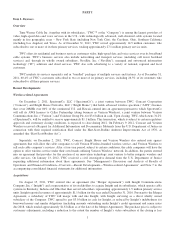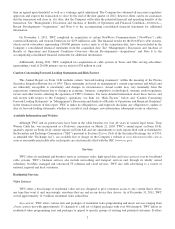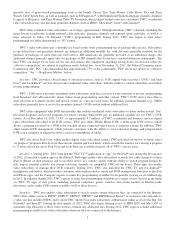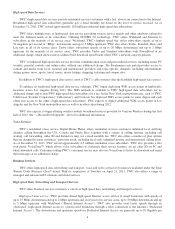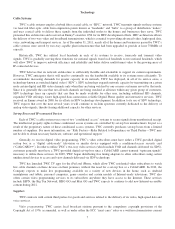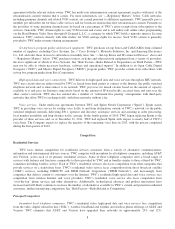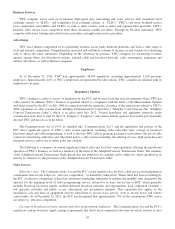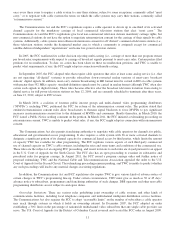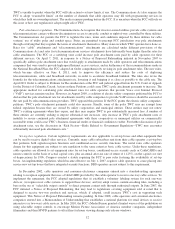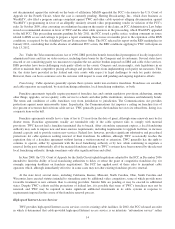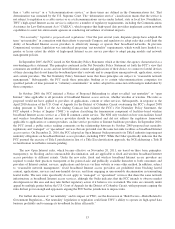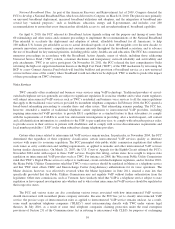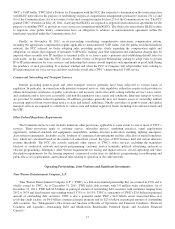Time Warner Cable 2011 Annual Report Download - page 18
Download and view the complete annual report
Please find page 18 of the 2011 Time Warner Cable annual report below. You can navigate through the pages in the report by either clicking on the pages listed below, or by using the keyword search tool below to find specific information within the annual report.Business Services
TWC competes across each of its business high-speed data, networking and voice services with incumbent local
exchange carriers, or “ILECs,” and competitive local exchange carriers, or “CLECs.” TWC’s cell tower backhaul service
faces competition from ILECs and CLECs, as well as other carriers, such as metro and regional fiber providers. TWC’s
business video service faces competition from direct broadcast satellite providers. Through its NaviSite subsidiary, TWC
competes with cloud, hosting and related service providers and application-service providers.
Advertising
TWC faces intense competition in its advertising business across many different platforms and from a wide range of
local and national competitors. Competition has increased and will likely continue to increase as new formats for advertising
seek to attract the same advertisers. Depending on the advertiser in question, TWC competes for advertising revenues
against, among others, local broadcast stations, national cable and broadcast networks, radio, newspapers, magazines and
outdoor advertisers, as well as Internet companies.
Employees
As of December 31, 2011, TWC had approximately 48,500 employees, including approximately 1,200 part-time
employees. Approximately 4.6% of TWC’s employees are represented by labor unions. TWC considers its relations with its
employees to be good.
Regulatory Matters
TWC’s business is subject, in part, to regulation by the FCC and by most local and state governments where TWC has
cable systems. In addition, TWC’s business is operated subject to compliance with the terms of the Memorandum Opinion
and Order issued by the FCC in July 2006 in connection with the regulatory clearance of the transactions related to TWC’s
2006 acquisition of cable systems from Adelphia Communications Corporation (“Adelphia”) and Comcast (the “Adelphia/
Comcast Transactions Order”), which is in effect until July 2012. Various legislative and regulatory proposals under
consideration from time to time by the U.S. Congress (“Congress”) and various federal agencies have in the past materially
affected TWC and may do so in the future.
The Communications Act of 1934, as amended (the “Communications Act”), and the regulations and policies of the
FCC affect significant aspects of TWC’s cable system operations, including video subscriber rates; carriage of broadcast
television signals and cable programming, as well as the way TWC sells its program packages to subscribers; the use of cable
systems by franchising authorities and other third parties; cable system ownership; the offering of voice, high-speed data and
transport services; and its use of utility poles and conduits.
The following is a summary of current significant federal, state and local laws and regulations affecting the growth and
operation of TWC’s business, as well as a summary of the terms of the Adelphia/Comcast Transactions Order. The summary
of the Adelphia/Comcast Transactions Order herein does not purport to be complete and is subject to, and is qualified in its
entirety by reference to, the provisions of the Adelphia/Comcast Transactions Order.
Video Services
Subscriber rates. The Communications Act and the FCC’s rules regulate rates for basic cable service and equipment in
communities that are not subject to “effective competition,” as defined by federal law. Where there has been no finding by
the FCC of effective competition, federal law authorizes franchising authorities to regulate the monthly rates charged by the
operator for the minimum level of video programming service, referred to as basic service tier or BST, which generally
includes broadcast television signals, satellite-delivered broadcast networks and superstations, local origination channels, a
few specialty networks and public access, educational and government channels. This regulation also applies to the
installation, sale and lease of equipment used by subscribers to receive basic service, such as set-top boxes and remote
control units. As of December 31, 2011, the FCC has determined that approximately 75% of the communities TWC serves
are subject to “effective competition.”
Carriage of broadcast television stations and other programming regulation. The Communications Act and the FCC’s
regulations contain broadcast signal carriage requirements that allow local commercial television broadcast stations to elect
10



